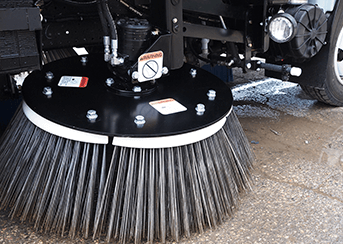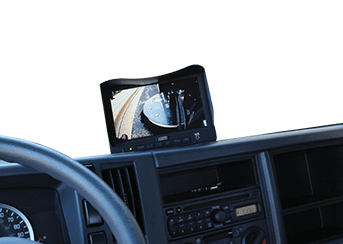Frequently Asked Questions
What are different types of sweeper technologies?
Architecture
Sweepers are classified based on 4 criteria's:
Way of transporting dirt from the street into hopper (container)
Way of transporting dirt from the street into hopper (container)
- air flow (vacuum and regenerative sweepers)
- mechanical (mechanical sweepers)
- air flow (regenerative sweepers)
- broom (mechanical sweepers)
- mixed (vacuum sweeper)
- dump on the ground/low dump (vacuum and regenerative sweepers)
- into a dump truck or container/high dump (mechanical sweepers)
- conventional chassis
- self-contain/purpose built
Vacuum requires more engine power leading to more fuel: A pneumatic conveying system used in vacuum sweepers, typically requires far more horsepower to operate than an equivalently sized mechanical conveying system. The reason is that changing the air pressure to achieve pneumatic conveying consumes a large amount of power and is inherently less efficient than a mechanical conveying systems mechanical transfer. In fact, in applications with the same transfer rate over the same conveying distance, a pneumatic conveying system can require 10 times the horsepower of a mechanical conveying system. An important portion of the vacuum system is maintained to eliminate all possible air leaks. Any damages in door seal, hopper ducts connections, hoses holes etc. decrease efficiency significantly.
Vacuum Sweepers require larger dust collection hopper & more water: A pneumatic conveying system requires a larger dust collection system than a mechanical conveying system. This is because the pneumatic system has to separate the conveyed material from the conveying air stream at the systems end. To slow down material (velocity) in order to be dropped to hopper's floor, sweepers are using water mist to make dust heavier and also fill up the bottom of the hopper with water to make it more sticky. If filtration is inefficient, dirt is entering fan with large speed, sandblasting surface of fan and housing or sticking to surface, putting the fan out of balance. Usually, fans are rotating with speed of 3,000 RPM
Vacuum Sweepers are inefficient in picking up some materials: Examples are material with large particle size and high bulk density, such as gravel or rocks, and extremely sticky material, which tends to build a coating on any material contact surface. In a pneumatic conveying system, such buildup often leads to total pipeline blockage.
Vacuum Sweepers require larger dust collection hopper & more water: A pneumatic conveying system requires a larger dust collection system than a mechanical conveying system. This is because the pneumatic system has to separate the conveyed material from the conveying air stream at the systems end. To slow down material (velocity) in order to be dropped to hopper's floor, sweepers are using water mist to make dust heavier and also fill up the bottom of the hopper with water to make it more sticky. If filtration is inefficient, dirt is entering fan with large speed, sandblasting surface of fan and housing or sticking to surface, putting the fan out of balance. Usually, fans are rotating with speed of 3,000 RPM
Vacuum Sweepers are inefficient in picking up some materials: Examples are material with large particle size and high bulk density, such as gravel or rocks, and extremely sticky material, which tends to build a coating on any material contact surface. In a pneumatic conveying system, such buildup often leads to total pipeline blockage.
Almost 60% of sweepers used in North America are mechanical sweepers. All mechanical sweepers are equipped with high dumping debris hopper. Why?
Sweepers with low dumping hopper are driven to the dump site to be offloaded or worse yet, dumped in a pile on the street, and then the debris is doubled handled by being shoveled into a container or dump truck to be taken to the recycling and disposal area.
It's been proved by various research, the dirt collected by sweeper from the streets contains hazardous metals that pollute the area used as temporary dumping locations by low dump sweepers. The dirt pollutes the nearby area and water bodies in case carried away by rain/stormwater. Double handling the dirt poses a threat of harmful diseases for people managing it.
When pointed out in this context, it seems that purchasing a high dump sweeper would be an obvious choice. With high dump hopper, debris can be unloaded in a tipper truck/container within seconds and the sweeper can be deployed again for sweeping. The truck can then carry it for safe disposal to landfills.
Sweepers with low dumping hopper are driven to the dump site to be offloaded or worse yet, dumped in a pile on the street, and then the debris is doubled handled by being shoveled into a container or dump truck to be taken to the recycling and disposal area.
It's been proved by various research, the dirt collected by sweeper from the streets contains hazardous metals that pollute the area used as temporary dumping locations by low dump sweepers. The dirt pollutes the nearby area and water bodies in case carried away by rain/stormwater. Double handling the dirt poses a threat of harmful diseases for people managing it.
When pointed out in this context, it seems that purchasing a high dump sweeper would be an obvious choice. With high dump hopper, debris can be unloaded in a tipper truck/container within seconds and the sweeper can be deployed again for sweeping. The truck can then carry it for safe disposal to landfills.
What works best on uneven and unpaved roads?
architecture
Mechanical sweepers work best on uneven and unpaved roads. The longer main broom assures the pick of material from even the unpaved roads.
Testing under, US-based organization, South Coast AQMD Rule 1186 uses a pass/fail approach to certify a sweeper's ability to pick up 80% of a material consisting of 90% sand and 10% paint filler, spread over 1000 lbs. per curb mile in an open-ended tunnel. About 3% of the test material consists of particles that are 10m or less. The normalized mass of entrained PM10 must be less than or equal to 200 mg/m.
PM-10 test is mandatory for all sweepers used in North America and Europe. It guarantees customer, that they not only buy an efficient sweeping machine but also sweeper with an excellent dust control system. This dust control system minimizes the number of harmful particles on the street that pollute the air.
PM-10 test is mandatory for all sweepers used in North America and Europe. It guarantees customer, that they not only buy an efficient sweeping machine but also sweeper with an excellent dust control system. This dust control system minimizes the number of harmful particles on the street that pollute the air.
- Small amount of power needed to sweep, mechanical/hydraulic devices have very high efficiency. Requires power 50% lesser than any air/vacuum sweeper
- The most versatile type of sweeper on market
- Sweeping quality similar to vacuum sweeper
- Optional unloading to dump truck or containers, increasing significant efficiency
- Works great in removing heavy material
- Sweeps well uneven surface because of the large diameter of the main broom
- Very easy to maintain, no need to seal air flow
Sweeper module/superstructure is designed to be installed on different domestic chassis or is part of a common platform with propulsion structure called purpose-built systems.
Conventional chassis is much more reliable, safer for drivers and more efficient than any purpose-built system. When service, maintenance, and repairs are required, they are provided at the local shops at a fraction of the price of purpose-built, especially built in foreign countries.
Unlike purpose-built machines, chassis mounted models allow operators to drive comfortable between jobs at highway speeds, resulting in increased productivity.
The chassis mounted design also allows for longer main broom bristles (due to rear-mounted main broom vs. belly/under frame) and substantially larger side brooms (due to chassis size), this results in better penetration of uneven surfaces, better handling heavy material, easier maintenance and lower cost.
Conventional chassis is much more reliable, safer for drivers and more efficient than any purpose-built system. When service, maintenance, and repairs are required, they are provided at the local shops at a fraction of the price of purpose-built, especially built in foreign countries.
Unlike purpose-built machines, chassis mounted models allow operators to drive comfortable between jobs at highway speeds, resulting in increased productivity.
The chassis mounted design also allows for longer main broom bristles (due to rear-mounted main broom vs. belly/under frame) and substantially larger side brooms (due to chassis size), this results in better penetration of uneven surfaces, better handling heavy material, easier maintenance and lower cost.
Yes. Challenger Sweepers has a comprehensive manufacturing facility at Pune, Maharashtra, India. Challenger modules are shipped from USA or Canada inside conventional containers and are mounted at our local workshop by our experts.
No results found












